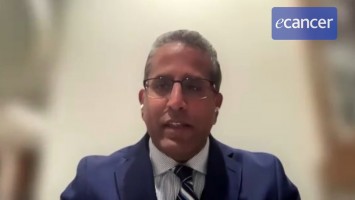ASCO 2011 Annual Meeting, 3—7 June 2011, Chicago
Optimal therapy for children with high risk ALL
Dr Eric Larsen – Maine Children’s Cancer Program, Portland, USA
I was fortunate enough to be chosen to be the study chair for the Children’s Oncology Group high risk ALL protocol, AALL0232, which began in 2004. It tested two basic study questions, one is to see if dexamethasone was superior to prednisone during induction and the other was to determine if high dose methotrexate was superior to capizzi methotrexate. Both of those study questions were an attempt to decrease CNS relapse which has been increasing relative to bone marrow relapse in the last fifteen years.
Because you don’t irradiate the brain anymore?
We do irradiate, what’s happened is there has not been an absolute increase in CNS relapse. What’s happened in the last 20-30 years is the continual improvements in bone marrow control and relatively static control in CNS.
So you’re not targeting CNS presumably?
Correct.
So tell us about the study, dex versus prednisone.
Dex versus prednisone, that was presented yesterday by Dr Naomi Winick and that’s been shown that dexamethasone appears to be superior to prednisone for younger children. That effect has not been seen in children over 10 and, in addition, patients over 10 seem to have a much higher rate of osteonecrosis with dexamethasone compared to prednisone. So the current recommendation in terms of induction steroid is dexamethasone for younger children, defined as a boundary of around 10 years of age, and prednisone for the older children.
And to review yesterday’s data, they’re superior in what outcome?
Event free survival.
And there could be another event then, brain metastasis or brain relapse
Correct.
And today’s question that you were answering?
Today’s question was actually the issue of high dose methotrexate compared to capizzi methotrexate.
What’s capizzi methotrexate?
Capizzi methotrexate, it’s actually relatively low dose methotrexate followed by asparaginase rescue and you escalate every ten days as tolerated. It was, in fact, this part of the question that led to the premature closure of the study during an interim analysis showed that clearly the high dose methotrexate arm was superior to the capizzi arm. It reached such statistical significance that we feel like even over time that that’s going to hold up. It was determined by the data safety monitoring board that it was time to halt the randomisation and at that point in time we offered high dose methotrexate to all children who were still early on in the trial.
Not everybody adopted the capizzi regime anyway.
Correct.
There were a lot of people who believed that high dose methotrexate got into the brain and actually probably did a reasonably good job there. So I suppose that pharmacodynamically it’s a good result and will back up what you would think.
And I think a lot of people will realise that both escalating capizzi methotrexate and high dose methotrexate have been around a long time, have been used; they’re both very effective arms but this is the first time that we really compared them head to head. Another phenomenon that’s happened is the single best treatment to control CNS leukaemia is radiation, however, it’s associated with some really significant side effects. As you may know in the history of ALL, when we first started to achieve long term remissions all children, 100% of children, relapsed in their CNS. And then when it was determined that the CNS was a sanctuary site, the immediate response to that was radiation – very effective. We used relatively high doses and the side effects were devastating. So the next step was to reduce radiation and then intrathecal therapies came in, to try to weave those in. But the focus has been on to try to decrease the late effects, so we’ve been sort of decreasing the CNS directed therapy and I think that has allowed some of this little increase that we’ve seen in CNS disease. And that’s the whole hypothesis of this study, to try to increase CNS control through systemic therapy.
How long before you know about the CNS data?
We have good data on the CNS now.
How many events have you got? Do you have enough?
We have enough now. So both the CNS and the bone marrow are statistically significant.
The next question in the Children’s Oncology Group?
For high risk patients? Well, the first thing that’s happening is we’ve adopted for B-cell precursor ALL all children should have some high dose methotrexate as part of their regimen; older kids prednisone during induction, younger kids dexamethasone. So the next study that we’ll be opening, probably late summer, early fall, we’re going to divide the high risk group into very high risk versus standard high risk, you may call them, and we’re still interested in trying to optimise CNS control. So the question for the lower high risk patients are going to be we’re actually going to randomise patients to intrathecal methotrexate versus what we call triple intrathecal therapy, which is methotrexate, cytarabine and hydrocortisone with the hypothesis that might be better. The very high risk patients will also be getting high dose methotrexate but there will be a three arm study that will be looking at the inclusion of cyclophosphamide, etoposide and there will be one arm that gets clofarabine, which is currently used for relapsed ALL and AML.
Thank you so much for giving us an update. Many of the adult oncologists here haven’t a clue about how to manage children with ALL, they just know that you do it better than we do with the adults with ALL or AML. Thanks very much indeed, Professor Larsen.
You’re very welcome.








